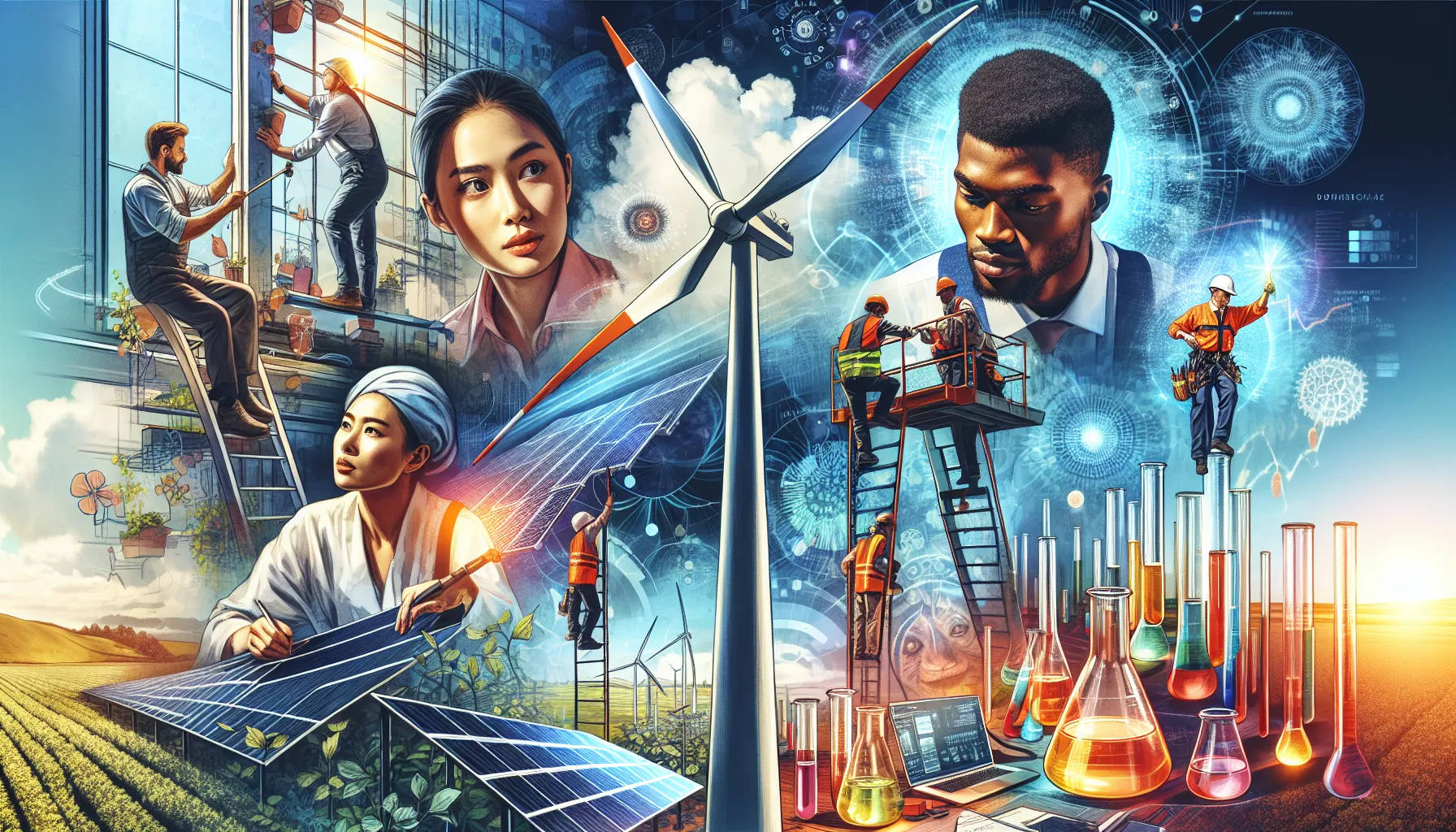Welcome to our IELTS Reading practice test focused on the impact of renewable energy on the economy. This comprehensive test will help you prepare for the IELTS Reading section by providing a realistic exam experience with passages of varying difficulty levels and a wide range of question types.
Introduction
The transition to renewable energy sources is not just an environmental imperative but also a significant economic opportunity. This practice test explores the multifaceted impact of renewable energy on global and local economies, covering aspects such as job creation, energy security, and technological innovation.
Passage 1 (Easy Text)
The Economic Benefits of Renewable Energy
Renewable energy has become a cornerstone of sustainable economic development in many countries. As governments and businesses increasingly recognize the potential of clean energy sources, investments in solar, wind, and hydroelectric power have surged. This shift is not only addressing climate change concerns but also stimulating economic growth and creating new employment opportunities.
One of the most significant economic impacts of renewable energy is job creation. The renewable energy sector has become a major employer, offering a wide range of positions from manufacturing and installation to maintenance and research. According to the International Renewable Energy Agency (IRENA), the sector employed 11.5 million people globally in 2019, a number that continues to grow year by year.
 Renewable Energy Jobs
Renewable Energy Jobs
Moreover, renewable energy contributes to energy security and price stability. Unlike fossil fuels, which are subject to price volatility and geopolitical tensions, renewable sources provide a more stable and predictable energy supply. This stability can lead to reduced energy costs for businesses and consumers, freeing up resources for other economic activities.
The adoption of renewable energy technologies also drives innovation across various industries. As companies invest in research and development to improve efficiency and reduce costs, they create new technologies that can be applied beyond the energy sector. This technological spillover effect can enhance productivity and competitiveness in the broader economy.
Rural areas, in particular, can benefit significantly from renewable energy projects. Wind farms and solar installations often bring new income streams to farmers and landowners, while also providing local tax revenue that can support community services and infrastructure improvements.
In conclusion, the economic impact of renewable energy extends far beyond the energy sector itself. By fostering job creation, enhancing energy security, driving innovation, and supporting rural development, renewable energy is playing an increasingly vital role in shaping the global economy of the future.
Questions 1-7
Do the following statements agree with the information given in the passage?
Write
TRUE if the statement agrees with the information
FALSE if the statement contradicts the information
NOT GIVEN if there is no information on this
- Renewable energy investments are primarily driven by environmental concerns.
- The renewable energy sector has created millions of jobs worldwide.
- Renewable energy sources provide more stable energy prices than fossil fuels.
- All countries have experienced economic growth due to renewable energy adoption.
- Technological innovations in renewable energy are limited to the energy sector.
- Rural communities can gain additional income from renewable energy projects.
- The economic benefits of renewable energy are expected to decrease in the future.
Questions 8-13
Complete the sentences below.
Choose NO MORE THAN TWO WORDS from the passage for each answer.
- The renewable energy sector offers jobs in areas such as manufacturing, installation, and ___.
- Unlike fossil fuels, renewable energy sources provide a more ___ energy supply.
- The stability of renewable energy can lead to ___ for businesses and consumers.
- Investment in renewable energy research creates a ___ effect that benefits other industries.
- Renewable energy projects can bring new ___ to farmers and landowners in rural areas.
- Local ___ from renewable energy projects can support community services and infrastructure.
Passage 2 (Medium Text)
Renewable Energy: Powering Economic Transformation
The global shift towards renewable energy is not merely a response to environmental concerns; it represents a fundamental economic paradigm shift with far-reaching implications for industries, labor markets, and international trade. As countries race to decarbonize their economies, the renewable energy sector has emerged as a powerful engine of economic growth and innovation.
One of the most significant economic impacts of renewable energy is its potential to reshape labor markets. The transition from fossil fuels to renewables is creating a surge in demand for skilled workers in fields such as solar panel installation, wind turbine maintenance, and energy efficiency consulting. This shift is not only generating new jobs but also necessitating the reskilling of workers from traditional energy sectors. Governments and educational institutions are increasingly investing in training programs to equip workers with the skills required for the green economy, ensuring a smooth transition and mitigating potential job losses in fossil fuel industries.
The renewable energy revolution is also driving substantial changes in global trade patterns. Countries with abundant renewable resources are positioning themselves as energy exporters, potentially altering long-standing geopolitical dynamics. For instance, nations with vast solar or wind potential are developing large-scale projects to produce green hydrogen, which can be exported as a clean energy carrier. This new “green energy diplomacy” is forging novel economic alliances and creating opportunities for developing countries to leapfrog traditional industrialization pathways.
Moreover, the renewable energy sector is becoming a hotbed of technological innovation, spurring advancements that extend well beyond the energy industry. Improvements in energy storage technologies, for example, are not only enhancing the viability of intermittent renewable sources but also finding applications in electric vehicles and consumer electronics. Similarly, smart grid technologies developed for managing renewable energy systems are contributing to the broader digitalization of infrastructure, improving efficiency across various sectors of the economy.
The financial sector is also undergoing significant changes in response to the renewable energy boom. Green finance initiatives, such as green bonds and sustainability-linked loans, are mobilizing capital for renewable energy projects at unprecedented scales. This shift in investment patterns is not only accelerating the energy transition but also reshaping financial markets, with sustainability considerations becoming increasingly central to investment decisions.
However, the economic transition to renewable energy is not without challenges. The intermittent nature of some renewable sources necessitates substantial investments in grid infrastructure and energy storage solutions. Additionally, the geographical distribution of renewable resources may lead to regional disparities in economic benefits, requiring careful policy considerations to ensure equitable development.
Despite these challenges, the overall economic outlook for renewable energy remains overwhelmingly positive. As technology costs continue to decline and efficiency improves, renewable energy is becoming increasingly competitive with fossil fuels, even without subsidies. This economic viability, coupled with the urgent need to address climate change, is driving a self-reinforcing cycle of investment, innovation, and adoption that promises to fundamentally transform the global economy in the coming decades.
In conclusion, the impact of renewable energy on the economy extends far beyond the energy sector itself. By driving job creation, reshaping global trade, spurring technological innovation, and transforming financial markets, renewable energy is catalyzing a comprehensive economic transformation. As this transition accelerates, it offers both challenges and opportunities for businesses, workers, and policymakers to shape a more sustainable and prosperous economic future.
Questions 14-19
Choose the correct letter, A, B, C, or D.
-
According to the passage, the shift towards renewable energy is primarily driven by:
A) Environmental concerns
B) Economic opportunities
C) Government regulations
D) International pressure -
The renewable energy sector is reshaping labor markets by:
A) Eliminating all jobs in traditional energy sectors
B) Creating demand for new skills and retraining workers
C) Reducing overall employment in the energy sector
D) Focusing exclusively on high-tech jobs -
The text suggests that renewable energy is changing global trade by:
A) Eliminating the need for energy trade between countries
B) Maintaining existing geopolitical relationships
C) Creating new opportunities for energy export and diplomacy
D) Increasing dependence on fossil fuel-producing nations -
Technological innovations in the renewable energy sector are:
A) Limited to improving energy production efficiency
B) Mainly focused on reducing costs
C) Having spillover effects in other industries
D) Slowing down due to lack of investment -
The financial sector’s response to renewable energy includes:
A) Avoiding all investments in energy projects
B) Focusing solely on traditional energy sources
C) Developing new financial products like green bonds
D) Decreasing overall investment in the energy sector -
The main challenge in transitioning to renewable energy, as mentioned in the passage, is:
A) Lack of public support
B) High costs of technology
C) Intermittency and infrastructure needs
D) Shortage of skilled workers
Questions 20-26
Complete the summary below.
Choose NO MORE THAN TWO WORDS from the passage for each answer.
The transition to renewable energy is driving a significant (20) in the global economy. It is creating new jobs and requiring the (21) of workers from traditional energy sectors. This shift is also changing (22) , with countries rich in renewable resources becoming potential energy exporters. The renewable sector is fostering (23) that benefits various industries beyond energy. In the financial world, (24) are emerging to fund renewable projects. Despite challenges such as the need for grid infrastructure and (25) , the economic prospects for renewable energy are positive. As costs decrease and efficiency improves, renewable energy is becoming (26) ___ with fossil fuels, driving further investment and adoption.
Passage 3 (Hard Text)
The Macroeconomic Implications of Renewable Energy Adoption
The proliferation of renewable energy technologies is catalyzing a profound transformation of global economic structures, with ramifications that extend far beyond the immediate confines of the energy sector. This transition is not merely a technological shift but a complex socio-economic phenomenon that is reshaping patterns of production, consumption, and international relations. As nations grapple with the imperatives of climate change mitigation and energy security, the macroeconomic implications of renewable energy adoption are becoming increasingly salient, demanding nuanced analysis and strategic policy responses.
 Global Economic Transformation
Global Economic Transformation
One of the most significant macroeconomic effects of the renewable energy transition is its impact on aggregate demand and economic growth. Large-scale investments in renewable energy infrastructure act as a powerful stimulus, generating multiplier effects throughout the economy. These investments not only create direct employment in manufacturing, installation, and maintenance but also stimulate demand in adjacent sectors, from raw materials to advanced electronics. Moreover, as renewable technologies mature and achieve cost parity with conventional energy sources, the resulting reduction in energy prices can boost disposable income and consumer spending, further driving economic growth.
However, the distributional effects of this transition are complex and potentially disruptive. While renewable energy adoption creates new economic opportunities, it also precipitates structural changes in labor markets and industrial bases. Regions heavily dependent on fossil fuel extraction and processing may face significant economic dislocation, necessitating proactive policies to facilitate economic diversification and workforce retraining. Conversely, areas rich in renewable resources may experience rapid economic development, potentially exacerbating regional inequalities if not managed judiciously.
The renewable energy transition also has profound implications for international trade and capital flows. As countries invest heavily in renewable technologies, new patterns of comparative advantage are emerging, reshaping global supply chains and trade relationships. Nations with abundant renewable resources or technological expertise in clean energy are positioning themselves as leaders in the green economy, potentially altering long-standing economic and geopolitical dynamics. Furthermore, the growing emphasis on sustainability in international finance is redirecting capital flows towards renewable energy projects and green technologies, influencing exchange rates and balance of payments dynamics.
The macroeconomic stability implications of renewable energy adoption are multifaceted. On one hand, the transition can enhance energy security and reduce exposure to volatile fossil fuel prices, potentially dampening inflationary pressures and improving trade balances for energy-importing nations. On the other hand, the intermittent nature of some renewable sources introduces new challenges for grid management and energy pricing, necessitating sophisticated policy frameworks to ensure stability and reliability.
Fiscal policy is another arena significantly impacted by the renewable energy transition. Governments face the dual challenge of incentivizing renewable energy adoption through subsidies and tax incentives while managing the potential erosion of revenue from fossil fuel taxes. This fiscal recalibration requires careful balancing to maintain budgetary stability while facilitating the energy transition. Additionally, the need for public investment in grid infrastructure and research and development presents both opportunities and challenges for fiscal policy, potentially influencing government debt levels and long-term fiscal sustainability.
The monetary policy implications of renewable energy adoption are equally profound. Central banks are increasingly factoring climate risks and the energy transition into their policy frameworks, recognizing the potential impacts on inflation, financial stability, and economic growth. The transition may influence the transmission mechanisms of monetary policy, altering the relationships between interest rates, investment, and economic activity. Moreover, the growing importance of green finance and sustainable investment criteria is reshaping financial markets, potentially affecting the efficacy of traditional monetary policy tools.
In the realm of innovation and productivity, the renewable energy transition is acting as a catalyst for technological advancement and efficiency gains across multiple sectors. The drive for more efficient renewable energy technologies is spurring innovations in materials science, energy storage, and smart grid systems, with potential spillover effects that could enhance overall economic productivity. However, the net impact on aggregate productivity remains a subject of debate, as the transition may also involve short-term disruptions and adjustment costs.
The global nature of the renewable energy transition also raises important questions about international coordination and governance. The need for harmonized standards, cross-border infrastructure, and coordinated research efforts underscores the importance of multilateral cooperation in maximizing the economic benefits of the transition while minimizing potential conflicts and inefficiencies.
In conclusion, the macroeconomic implications of renewable energy adoption are vast and multifaceted, touching upon virtually every aspect of economic policy and performance. As the transition accelerates, policymakers, businesses, and researchers must grapple with a complex web of opportunities and challenges. The successful navigation of this transition will require not only technological innovation but also economic creativity, policy flexibility, and a commitment to equitable and sustainable development. The renewable energy revolution is thus not merely a shift in energy sources but a fundamental reimagining of global economic structures and relationships.
Questions 27-32
Choose the correct letter, A, B, C, or D.
-
According to the passage, the transition to renewable energy is primarily characterized as:
A) A purely technological shift
B) A complex socio-economic phenomenon
C) An environmental initiative
D) A political movement -
The impact of renewable energy investments on economic growth is described as:
A) Negligible
B) Limited to the energy sector
C) Having multiplier effects throughout the economy
D) Detrimental to consumer spending -
The passage suggests that the distributional effects of the renewable energy transition are:
A) Uniformly positive across all regions
B) Limited to areas with renewable resources
C) Complex and potentially disruptive
D) Easily managed without policy intervention -
The impact of renewable energy adoption on international trade is characterized by:
A) Maintaining existing trade patterns
B) Decreasing global trade volume
C) Reshaping global supply chains and trade relationships
D) Exclusively benefiting developed countries -
According to the text, the fiscal policy challenges of the renewable energy transition include:
A) Only increasing tax revenue
B) Balancing incentives with potential revenue loss
C) Eliminating all subsidies for energy
D) Focusing solely on short-term budgetary concerns -
The passage suggests that the renewable energy transition’s impact on innovation and productivity is:
A) Entirely negative
B) Limited to the energy sector
C) Potentially beneficial with spillover effects
D) Fully understood and quantified
Questions 33-40
Complete the summary below.
Choose NO MORE THAN TWO WORDS from the passage for each answer.
The macroeconomic implications of renewable energy adoption are extensive, affecting various aspects of the global economy. Large-scale investments in renewable energy act as a (33) , creating jobs and stimulating demand in related sectors. However, this transition may cause (34) in labor markets and industrial bases, requiring policies for economic diversification and workforce retraining.
The shift to renewables is altering (35) and capital flows, with countries rich in renewable resources gaining new economic advantages. This transition can enhance (36) and potentially reduce inflationary pressures for energy-importing nations. However, the intermittent nature of some renewable sources presents challenges for (37) ___ and energy pricing.
Governments face challenges in (38) to encourage renewable adoption while managing potential revenue losses. The transition is also influencing monetary policy, with central banks considering climate risks in their frameworks. In terms of innovation, the renewable energy transition is spurring advancements that could enhance overall (39) .
The global nature of this transition highlights the need for (40) ___ to maximize benefits and minimize conflicts. Successfully navigating this transition requires not only technological innovation but also economic creativity and policy flexibility.
Answer Key
Passage 1:
- FALSE
- TRUE
- TRUE
- NOT GIVEN
- FALSE
- TRUE
- NOT GIVEN
- research
- stable
- reduced energy costs
- technological spillover
- income streams
- tax revenue
Passage 2:
- B
- B
- C
- C
- C
- C
- economic paradigm shift
- reskilling
- global trade patterns
- technological innovation
- Green finance initiatives
- energy storage solutions
- competitive
Passage 3:
- B
- C
- C
- C
- B
- C


